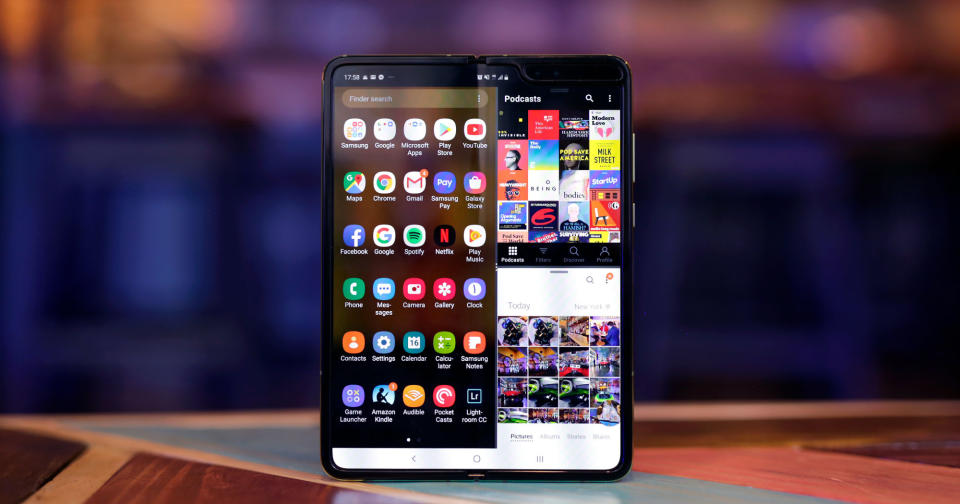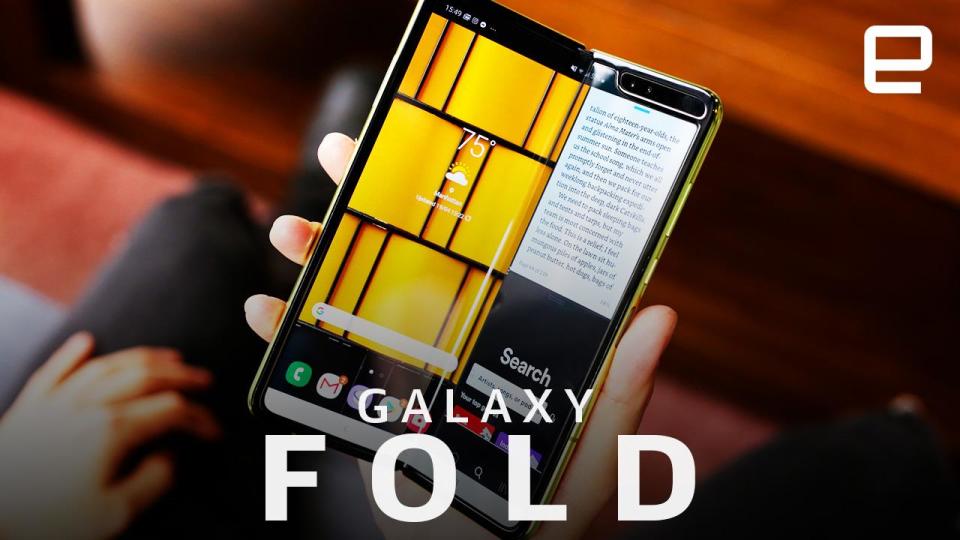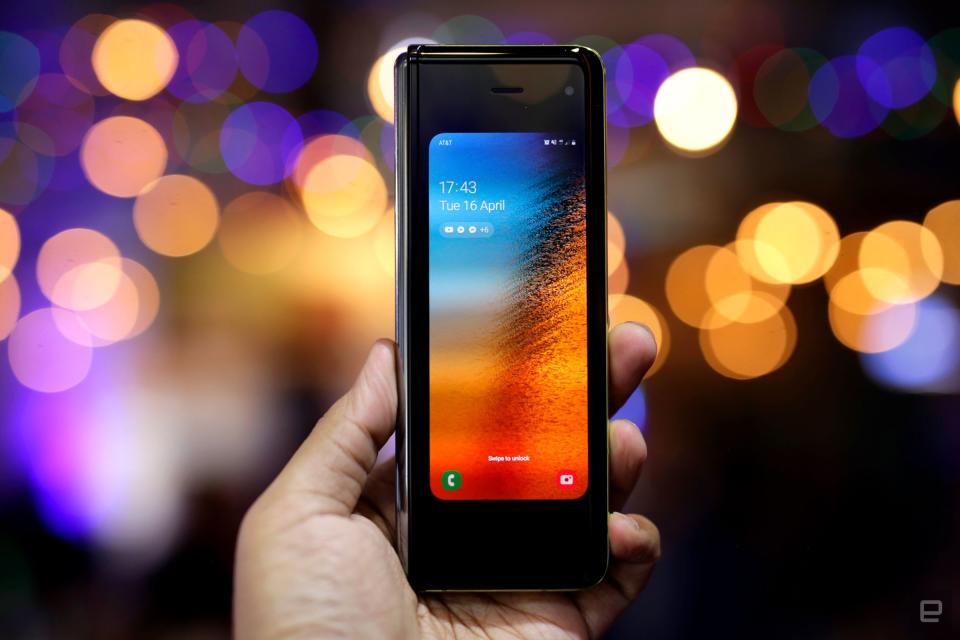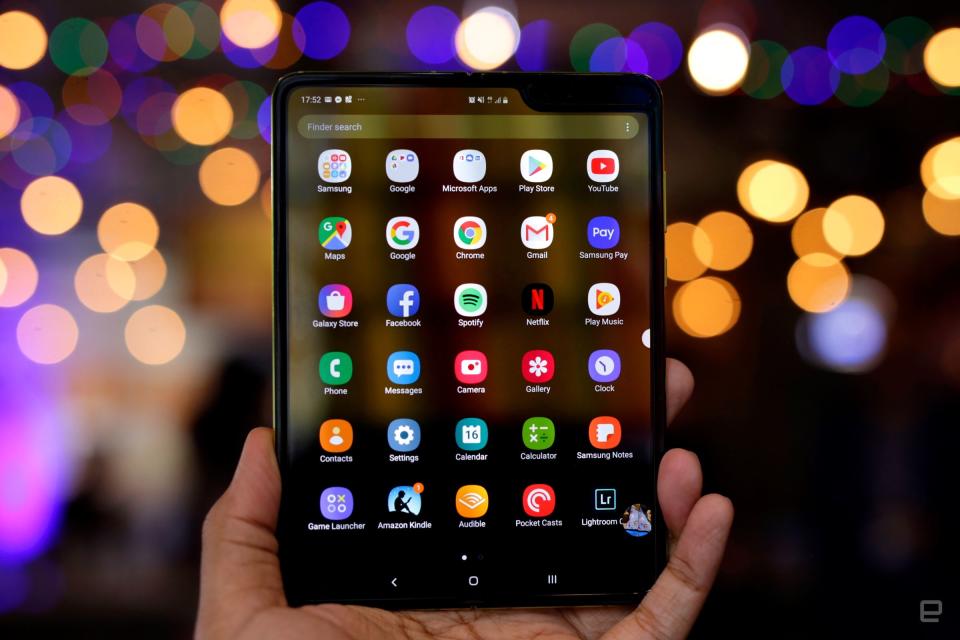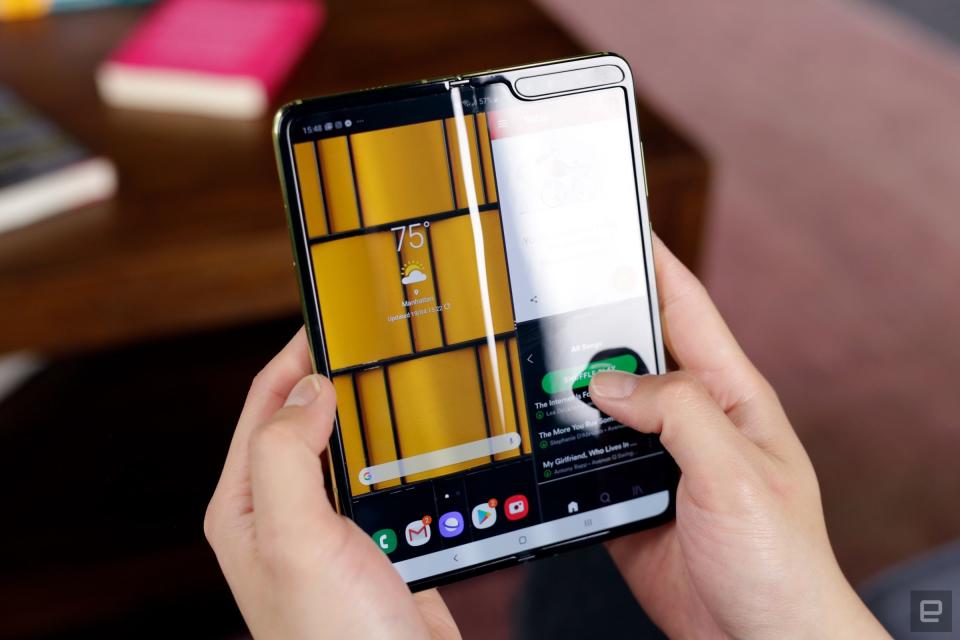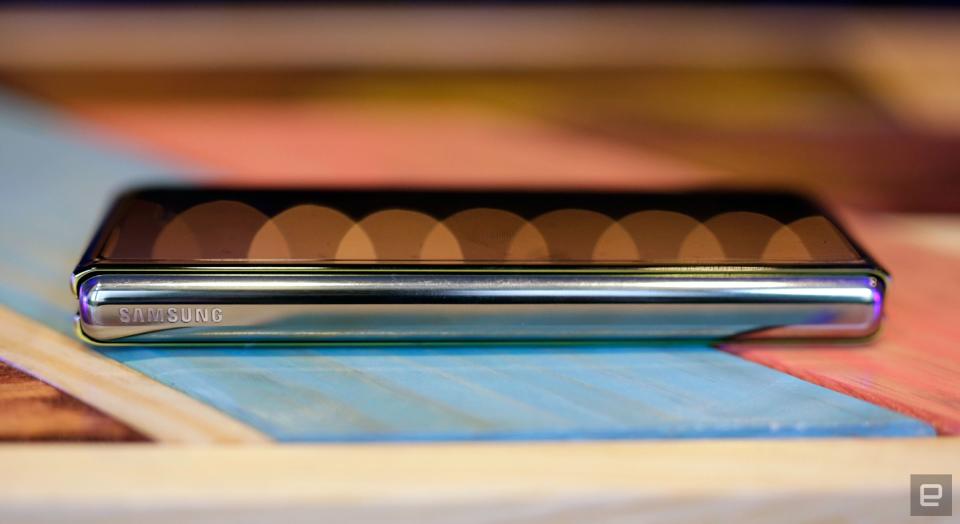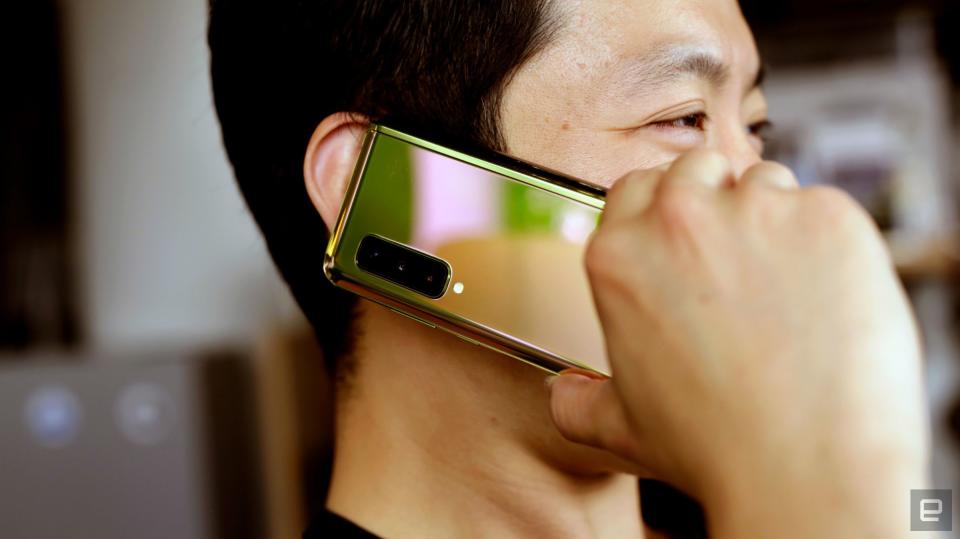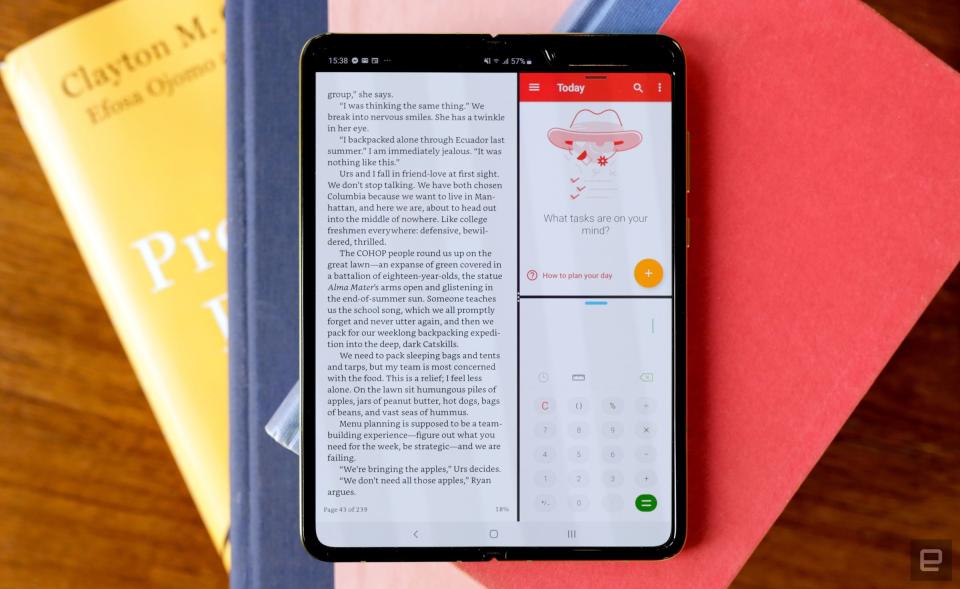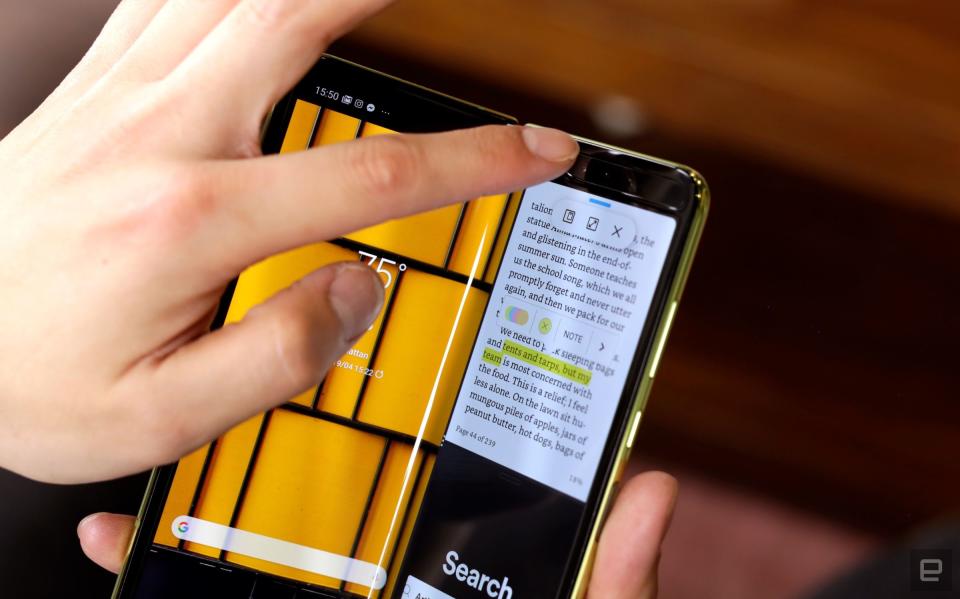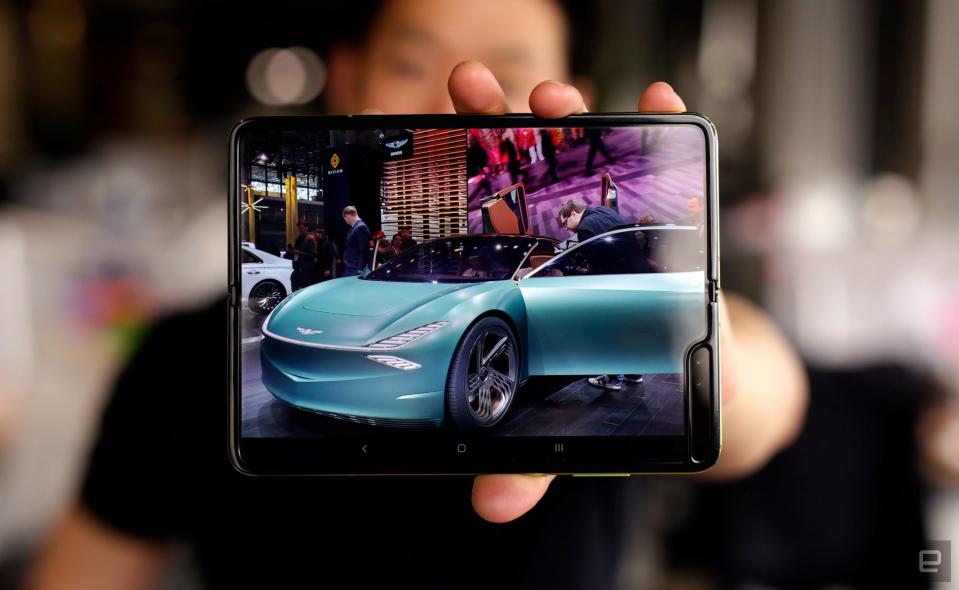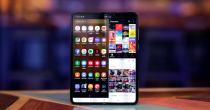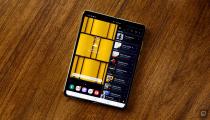Galaxy Fold review: A lot of money for a prototype
It's a taste of the future, a costly experiment and an uneven first step.
Click. Smack. Click. Smack. Click. Smack.
I feel bad for the people in my life, because everywhere I've been for the past week, the sounds of opening and closing Samsung's Galaxy Fold have followed. Even if you're not prone to fidgeting, this $1,980 smartphone will do that to you. It might not be the first commercially available foldable device, but it is the first one from a company with the global influence to make foldable phones a reality for everyone. And it's a lot of fun to open and close endlessly. Click. Smack. Click. Smack.
The Galaxy Fold is far more than just a party trick though: It contains multitudes. The Fold represents a new way of thinking about what modern phones should be able to do. It's an impressive technical achievement. Perhaps more than anything, though, it's a fragile, uneven first step down a path toward a new kind of personal computing.
That's a mild way of saying that the Fold is profoundly cool but that almost no one should actually consider buying one. If you do, you're basically agreeing to be Samsung's guinea pig as it tries to figure out how to make this new kind of device truly valuable. At this point, the Galaxy Fold is a glorified bit of beta hardware. But even with all of its compromises, it offers a glimpse of a future that -- for me, anyway -- can't come soon enough.
Author's note: The review unit Samsung provided to us is an early European production model. Among other things, that means it doesn't fully support the LTE bands of most major US carriers, and it has some hardware and software issues that Samsung will hopefully iron out in later production runs. Because of that and other concerns raised by reviewers, Samsung is reportedly pushing back the Galaxy Fold's launch date until "at least next month."
We stand by the content of this review: It represents the experience that owners of the first Galaxy Fold units could expect to live with. That said, we won't give this device a review score until we test a US production model in the coming weeks and evaluate Samsung's (currently undefined) after-sale support plans.
Hardware and design
In building a smartphone, device makers have to balance performance, usability and price. The Galaxy Fold is a little different. By its very nature, it emphasizes flexibility above almost everything else, and that's what makes it such a fascinating device to live with.
Sure, all the usual premium smartphone bits are here and then some: There's a high-powered Snapdragon 855 chipset with 12GB of RAM inside, plus 512GB of internal storage, six highly capable cameras and a pair of batteries with a combined capacity of 4,380mAh. And to help make that whopper of a price tag a little easier to swallow, the Fold comes with a case and a set of Samsung's all-wireless Galaxy Buds in the box.
Of course, the real reason anyone cares about the Galaxy Fold is its two screens.

When the Fold is closed, it feels like a phone from more than a decade ago. It's tall and chunky in a way that's reminiscent of Nokia's old flip-open Communicators, and you'll spend most of your time out here working on a narrow, 4.6-inch Super AMOLED display. I had my concerns about this -- after all, framing up photos or using apps on a screen this cramped can't be a pleasant experience, right? Thankfully, the reality isn't that bad. Most of your apps will run fine on this narrow display, though you will see some occasionally struggle to adjust their layout. You can even play games on it, if you're a glutton for punishment.
Since I have pretty big hands, typing on this display took the most getting used to. After a week of testing, I've managed to get pretty good at it, but most people will probably prefer dictating their texts and emails for better accuracy. If you have dainty fingers, well, you shouldn't have nearly as much trouble. Either way, the outer display wasn't designed to be used for long periods of time. It's ultimately best suited to brief interactions, like glancing at messages or seeing how far away your Uber is.
The real draw here is the 7.3-inch Infinity Flex display that softly clicks into place when you open the Fold. It's a Super AMOLED screen, sort of like the ones you'll find on Galaxy S10, but the similarities end there. In order to make the screen flexible enough for folding, Samsung had to make its AMOLED panel dramatically thinner and add multiple polymer layers on top to protect it (including one you definitely shouldn't remove).
In typical Samsung fashion, the display is beautiful and crisp despite "only" running at 2,152 x 1,536 resolution. For those keeping count, that works out to a pixel density of 326 ppi, far short of any of the Galaxy S10 devices. Even the ever-present crease isn't as bad as I had feared. It's plainly visible when you look at the screen from an off angle, but when you're gazing at it dead on, it barely registers. After my week with the Fold, I've largely stopped noticing the crease, sort of like how the once-odious notch now tends to fade into the background. Besides, the flexibility of having a big display that disappears when you need it ultimately outweighs the crease's fundamental oddness.
That the screen is this pleasant to look at is a testament to Samsung's wizardry with displays, though I do wish it were a little brighter. And even beyond that, it's a long way off from perfect.

The screen conundrum
For one thing, the display often exhibits what's known as jelly scrolling: In this case, content on the right side of the screen moves more quickly than on the left. It's most apparent when you're quickly whipping through long stretches of text and photos (like this review, for instance). Since that's not generally how I use my phone, I almost missed this at first.
When you're taking your time scrolling through apps and content, it's hardly even noticeable. How annoying this issue is largely depends on the person: Some people I showed the Fold to couldn't see what I was talking about while others pointed it out to me immediately. Regardless, it's happening, and I can't help but expect more from a $2,000 phone. And the problems don't end there.
The downside of this kind of flexible screen is that it's much less durable than the glass-covered displays you'll find on most other phones. Granted, since the Fold is going to be closed whenever you slip it into a pocket or a purse, that relatively soft screen is shielded from the sort of everyday damage that a foldable with a fully external screen will have to endure. But how well is the Fold's screen going to hold up when it invariably lands facedown on a desk or on asphalt?

Samsung has specifically barred reviewers from performing any kind of drop testing on the Fold, so for now your guess is as good as mine. For what it's worth, the Fold has shrugged off a few accidental drops onto desks and low tables. Even though I haven't had this thing for long, its inner screen has already started to pick up small nicks and dings that I can't rub out of that protective layer with my finger. Needless to say, the longevity of this screen remains a big concern.
Speaking of that protective layer, do not try to remove it. It looks like a screen protector, and in a manner of speaking it is, but it's also a crucial part of the display itself. As some reviewers have already shown, though, peeling back that topmost layer of plastic almost certainly spells doom for the screen. To be fair to Samsung, there's nothing -- no indicator, no plastic tab, nothing -- that suggests the plastic layer is meant to come off. Even so, the fact that we're even having this conversation is proof that Samsung failed to make that abundantly clear.
Oh, and there's more. The phone isn't IP-rated for water or dust resistance, and that's at least partially due to the Fold's hinge design. When the phone is closed, there are long, thin gaps between the hinge and the Fold's two halves. I haven't tried sticking anything in there, but I have to wonder what would happen if some rain or pocket debris squeezed its way into the phone through those gaps. Nothing good, I imagine.
Update (4/22, 1:05 PM): We had good reason to be troubled by the Fold's hinge design. In a statement confirming the Galaxy Fold's launch delay, Samsung said display issues "could be associated with impact on the top and bottom exposed areas of the hinge." The company said there was also an instance where substances found inside the device affected the display performance, though at this point we're not sure if those "substances" were already inside the phone when it was given to a reviewer or if they entered the phone some other way.
As much as I enjoy using the Fold, there's no way to guarantee that these displays will last a long time. The concerns raised here, and by other reviewers, have apparently prompted Samsung to push back its original April 26th launch date into next month at the earliest. Even then, I have to wonder how much Samsung can improve these devices before they start shipping to consumers: Galaxy Folds are already rolling off production lines, and the company can't redesign the whole thing from scratch now.
Damaged phone screens are nothing new; if the number I've seen on the New York City subway alone is any indication, broken screens are reaching epidemic proportions. The real issue with the Fold is that as futuristic as it is, it's more fragile than a $2,000 phone should be.
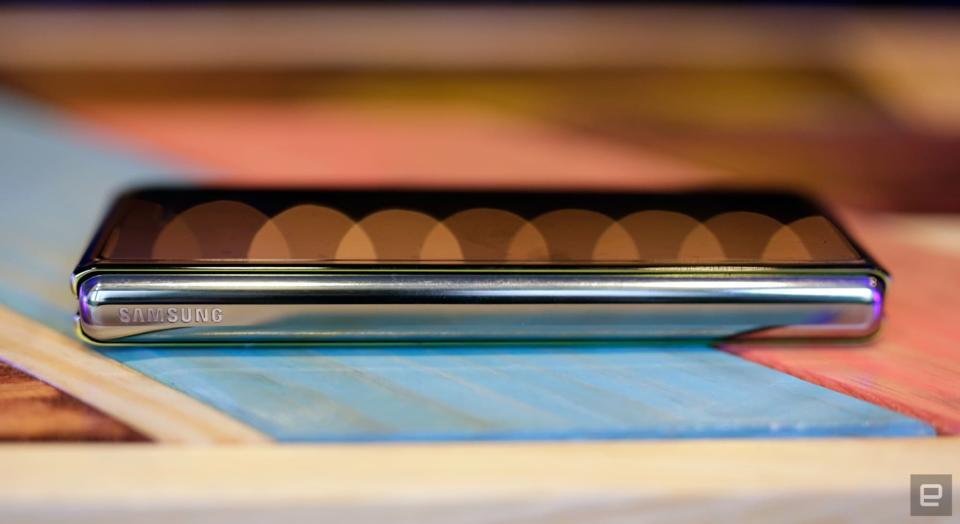
In use
Samsung needs to figure this out, because once you put all those potential issues aside, using the Fold feels like a game changer. Remember the flexibility I mentioned earlier? It's intoxicating. The ability to whip a (relatively) compact phone out of my pocket, open it and instantly work on a tablet-size screen is valuable enough to make me forget about most of those concerning what-ifs.
As I've said before, the Fold doesn't exactly shine when you're using it closed. Its long body means it's great for phone calls, but the power button, volume keys and the combination Bixby button/fingerprint sensor all live very close to one another. I can't begin to tell you how often I accidentally activated Samsung's virtual assistant before I remapped the button entirely. More than anything, though, getting things done on that small screen is a hassle. That's where Samsung's App Continuity software comes into play: It ensures that whatever's happening on the phone's tiny outer screen keeps happening on the big one. And for the most part, it works well.
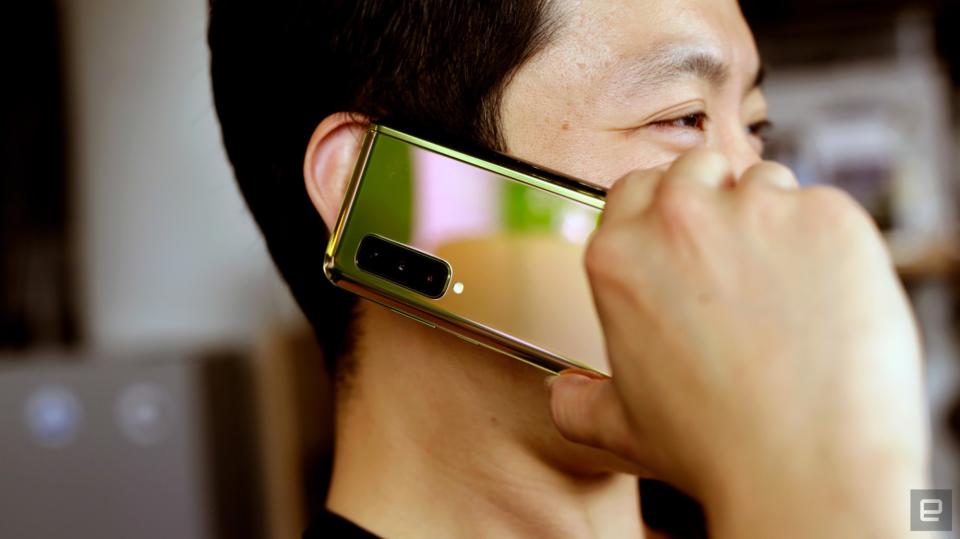
Most of the software I use regularly, like Kindle, Chrome, Slack, Gmail, Todoist and Twitter, handles the big-screen transition without fuss, allowing me to pick up where I left off. Other apps, like Lightroom CC, aren't quite as graceful. In those cases, opening the Fold reveals a standard smartphone-sized app window flanked by big black bars. This hasn't happened often since I started testing the Fold, but the fix is always the same: You have to close the app and restart it on that big screen to get the full effect. If you happen to rely on apps that don't fully support the Fold's screen trickery, this is going to get old fast.
By default, App Continuity only goes one way: from small screen to big. That's apparently because Samsung believed that when people close the Fold, they're done doing whatever it is they wanted to do in the first place. You can, however, set the Fold to pass certain apps back to the small screen if you want to. It takes a quick trip into the settings to make this happen, and in general, I think Samsung made the right call here. I don't want to keep looking at my banking app once I close the Fold, but reverse App Continuity has been handy when someone sits next to me on the subway while I'm reading a Kindle book. In that moment, I want to take up less space, and the feature works beautifully.
The fact that the Fold can keep up with the little details of my life like that is part of what makes it so appealing. There's almost always enough phone to suit whatever situation I find myself in.
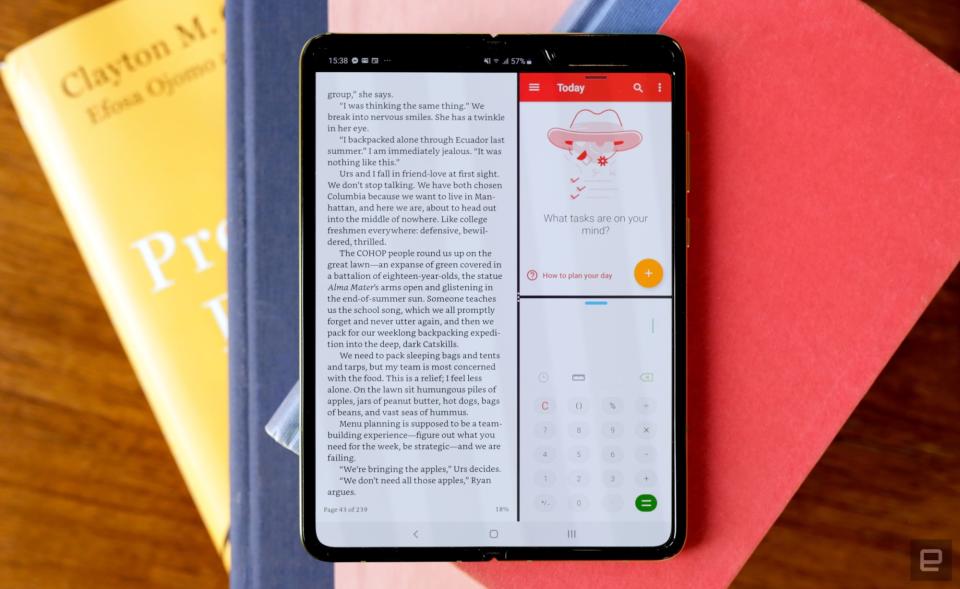
Consider this: I recently spent a day running around the New York Auto Show, trying to coordinate assignments with a colleague and a cameraperson. The Fold's Multi-Active Window feature was a lifesaver: With some setup, you can have three different apps running in a grid that fills the entire 7.3-inch screen. You can technically get up to five apps running simultaneously if you let two of them run in floating windows, but if you need that many active apps, you might want to consider some life changes. (Or, you know, a laptop.)
In any case, I spent that day with a Google Drive spreadsheet open in the biggest app window while a group chat with my co-workers and my to-do list sat stacked on the right side. Could I have managed all that by switching between apps on a regular smartphone? Sure, but having those three crucial apps staring at me in one place genuinely made me more productive.
Getting everything where I wanted it took time, though, and a lot of experimentation. The easiest way I've found to get this grid of apps going is to already have your primary app open and swipe from the right side of the screen. You'll see a narrow tray of apps pop up, and you can drag one into position to the right of the main app. Repeat that process once more to get another app running above or below the one you just set up.

From there, it's easy to swap apps in and out as needed; just open that tray up again and drag a new app into one of those windows. You're also supposed to be able to select one of the smaller app windows (by tapping a little lozenge at the top) and choose an app to replace it, but, uh, that doesn't work. On my review unit at least, it didn't matter what app window I selected; the app I chose to replace it appeared in the bottom window.
It didn't take long for things to get more confusing. When you exit to the home screen, the two apps that stack on top of each other disappear. Sometimes you can swipe right on the screen again to bring them back. Other times, though, they're gone for good. I can't rule out the possibility that I've been doing something wrong, but there aren't any clear instructions available. Multitasking here has a lot of promise, but Samsung needs to make the experience much easier to understand and use.
But not everyone who buys the Fold is going to use it for hardcore multitasking. Just using the Fold as an ultra-portable Android tablet is mostly a pleasure. The spacious display makes typing a breeze, and while I'm sure Samsung didn't mean to, it built arguably the best e-reader on the market. Most of the games I tried handled the large screen nicely too. Some like PUBG Mobile take up the whole display while others like Another Eden run in the center of the screen with some neat little designs to fill up the empty space around them. I'm sure others won't play nearly as well on the Fold because of its inherent strangeness, but so far, so good. Mostly.
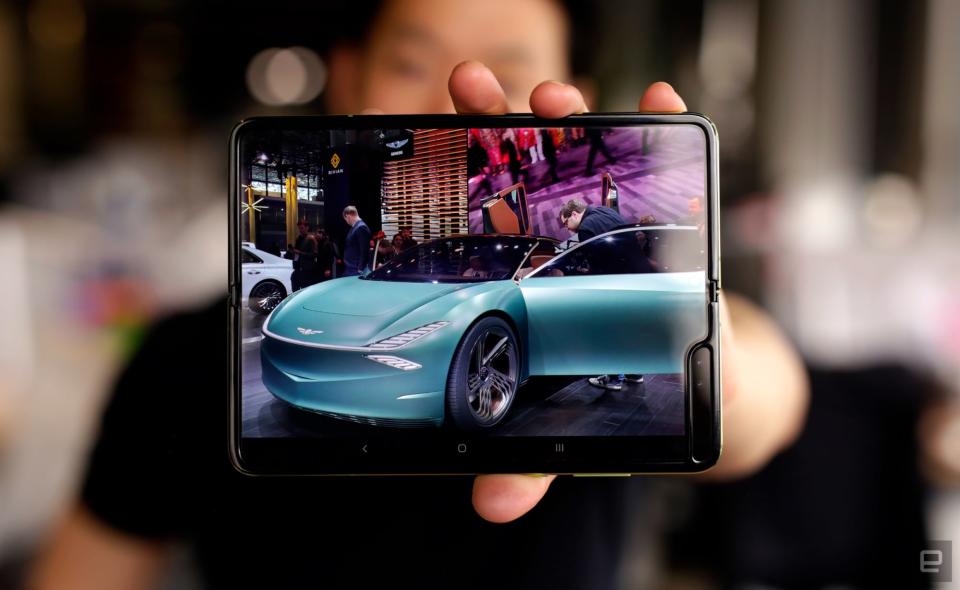
That said, there are a few more issues to note. By default, watching videos on the Fold is less than ideal, because its big corner notch juts into the corner of the frame. (Hey, Samsung: If there were ever a smartphone that could benefit from a hole-punch cutout for the front cameras, this is it.) You can fix this issue by setting the phone to hide the notch entirely, but Samsung buried this helpful option deep in the phone's settings.
The number of tablet-optimized Android apps is pretty small, too, and whether you get that experience on the Fold seems like a crapshoot. Only a few apps, like Gmail, recognize that it should serve the Fold its tablet interface; every other app I've tested treats this thing like a big phone with a slightly weird, 4.2:3 aspect ratio. Some apps like Instagram fill both of the Fold's screens but not correctly. When I was sifting through people's Insta Stories, the tops and bottoms were always cut off. On the smaller, front-mounted screen, the sides were truncated. Google is bringing proper support for foldable devices to its forthcoming Android Q release, but until then, developers who care about supporting early foldables will have to put in some Galaxy Fold-specific extra work here.
The Galaxy Fold is about as unorthodox as smartphones get right now, but at least it gets some of the basics right. Even though driving two screens is no small feat, the Fold has averaged between six and seven hours of screen-on time without breaking a sweat. In real-world use, the battery life has been more than enough to last around 18 hours off a single charge. Wireless charging works in both directions here, so you can power up the phone without a cable and use the phone itself to charge those included Galaxy Buds. I'd recommend charging the traditional way, though, because filling up both of the Fold's batteries takes time: around two hours if you're using a fast charger to revive a dead phone.
The Fold's cameras are largely great, too, though that shouldn't be a surprise. After all, it shares its 16-megapixel ultra-wide, 12MP wide and 12MP telephoto cameras with the Galaxy S10 line. We've already covered these cameras in depth in our Galaxy S10+ review, so I won't repeat myself much here. Just know that the Fold can capture some stunning photos, with ample detail and vivid colors. That is, when there's plenty of light around you. As capable as the three of these cameras are, neither one of them particularly excels at indoor, low-light situations, so don't be surprised when the photos of your night out don't turn out quite as well as you'd hoped.
If you're a photographer in search of a real challenge, you can use the Fold's tiny external display to frame your shots. Here's a pro tip for everyone else: Don't. Seeing people taking photos in public with their tablets has always been good for a laugh, but using the Fold's big screen to line up photos has been an unexpected joy. There is one final issue I have to point out though. Even though this phone has the best mobile processor out there and a whopping 12GB of RAM, I occasionally noticed a long delay between hitting the shutter button and the pictures actually getting saved to the camera roll. The issue has been rare enough that I wouldn't call it a dealbreaker, but here's hoping Samsung issues a software update soon.

In all my years of covering hardware, I've never tested a device quite like the Galaxy Fold. It represents a tremendous technical achievement, and I don't think I'm exaggerating when I say it's going to change what you expect from a phone. Based on my experience and that of other reviewers, I have serious concerns about how long this phone will hold up over time. To put it succinctly, the Galaxy Fold is frustrating and fantastic in almost equal measure.
I'd normally wrap things up by debating whether or not the device is worth buying, but I think we both know the answer to that. So how about this: For the past day or two, I've tried putting the Galaxy Fold down and using other smartphones again. That impulse never lasts for long. In just a week, I've already become spoiled by the Fold's flexibility, the potential to do more on a single device. I don't want to go back to anything else, even though I don't have much choice. The Fold is full of caveats, almost too many to count. But at the end of the day, it's a crucial first step, and hopefully an omen of better experiences to come.


